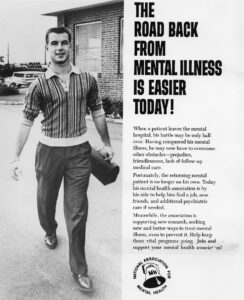From Volunteers to Professionals
 The first White Cross centres were run by lay women who previously visited with patients at Weyburn and North Battleford provincial mental hospitals. These volunteers entertained former patients in their homes, which might surprise some people, and encouraged people living in group homes to get together at the White Cross Centres for fun and conversation in the evenings.
The first White Cross centres were run by lay women who previously visited with patients at Weyburn and North Battleford provincial mental hospitals. These volunteers entertained former patients in their homes, which might surprise some people, and encouraged people living in group homes to get together at the White Cross Centres for fun and conversation in the evenings.
While volunteers continued to be important in CMHA rehabilitation efforts, professional social workers and psychologists soon moved in to direct the White Cross programs. By 1958, the Saskatoon Centre had expanded to employ a full-time social worker, detailed in this 1955 document, as more patients from Saskatchewan Hospital in North Battleford needed help finding a job and a place to live. A social worker or psychologist focused on restoring a person to a “full and satisfying life” by assessing the needs and problems of the person’s health, social and life circumstances, as well as perceived emotional or psychological problems.
The social worker would interview the patient to determine the patient’s motivation, interpret the illness to family, employer and others directly concerned. The social worker would help the patient make use of available treatment and vocational adjustment along with personal and social adjustment. The patient should do as much as he [or she] is capable of.
With the ultimate goal of finding mainstream employment for people returning to the community, the social worker evaluated this process: “Vocational help and job finding were necessary, but one of the more difficult functions.” It was very difficult for former patients to find their way into the labour force and. employers were reluctant to take a risk on someone for whom occupational programs in hospital were their previous “work experience.”

The social worker acted as a liaison with the hospital. Hospital psychiatrists provided discharge information to assist in follow-up, though some were reluctant to do so. The social worker was expected to know the community resources including the Department of Welfare, and to foster relationships with potential employers.
Reflecting a change of emphasis from pilot project to permanent CMHA program, the new director, Joyce Harman, staffed the Regina White Cross Centre, managed the clubs in Saskatoon, Swift Current and Weyburn, and was expected to expand the program to North Battleford and Prince Albert. Her complex duties listed in this 1960 document included guidance and leadership for volunteers, liaison with mental hospitals, professionals and clubs, public speaking, public education and working with the media.
